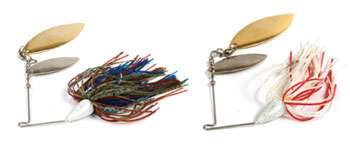
Designed any skirts lately?
Kevin VanDam has. So have Guido and Dion Hibdon … and Ken Cook.
But before you try to hire one of them as your wife’s fashion consultant, be informed: We’re talking spinnerbait and jig skirts.
The plain-pallet skirt thinking that reduced spinnerbait choices to chartreuse, white and black is yielding to a better reasoned fly tier’s mentality today.
“Why do we reach for white and white with chartreuse spinnerbaits even in the spring in stained water when most of us would use dark jigs in the same conditions?” asks Stephen Headrick, Dale Hollow’s “smallmouth guru” and creator of Punisher Lures, Celina, Tenn. “Isn’t a spinnerbait a jig with a spinner?”
“Some guys say, ‘Give me a chartreuse or white spinnerbait, and I’m ready to go,'” says VanDam, who knows a thing or two about fine-tuning baits and presentations. “But when you get to really clear water situations, you’d better have some match-the-hatch-type skirts.”
The four-time Toyota Tundra Bassmaster Angler of the Year brought such skirt patterns as green shad, smoky shad and true bluegill to the Signature Series of spinnerbaits he developed for Strike King, but he still carries a skirt-making kit when he’s on the water for when he needs a better forage match or a touch of flash. KVD applies the same logic to his jig skirt choices, frequently opting for colors to match crawfish and bream.
In clear water lakes with a shad or alewife forage base, Cook uses a skirt of clear silver silicone with glitter, adding six to eight strands of chartreuse and/or blue. In muddy water, on the other hand, it’s all about just being seen.
“Contrast needs to be enhanced when you’re fishing muddy water,” says Cook, who sports a biology degree in addition to his Elite Series credentials. “I’ll go with brighter chartreuse and white or chartreuse and red or orange under these conditions.”
Chaging On The Fly
“Most fishermen wait too late to make a color adjustment,” says Brad Wiegmann. The Beaver Lake guide from Springdale, Ark. (479-756-5279, bwieg mann@cox.net), is a big believer in dialing into forage patterns. “When I catch a fish, I look in its mouth immediately. You may see a tail of a baitfish. If not, I put the fish in the livewell for a while. Often they’ll disgorge an earlier meal, and I try to match that.”
Wiegmann credits some of his skirt logic to Guido and Dion Hibdon. The only father-son Bassmaster Classic winners, the Hibdons tailor skirt patterns on the water to match dominant forage or to add visibility or attraction. (Hibdon’s Classic Kits — complete kits of skirt-making materials and tools — are available from Skirts Plus.)
“We created a skirt that’s just about identical to a blueback herring and caught the heck out of spotted bass on Lake Lanier,” relates Guido.
The Hibdons’ credo is “You can match anything,” provided you have a good eye and the right tools.
The dark back is a common theme in his patterns. So is contrast.
Bluegill make up the biggest portion of a bass’ diet in many waters. “Clear silicone with gold glitter, a few strands of green, a few strands of chartreuse and finally a few strands of orange on the bottom give the skirt the bluegill look I like,” says Cook. “Those few strands of orange make a big difference, especially after bass spawn and the water has a little color to it. The bluegill are spawning right after the bass, and they get bright.”
Many forage species — especially those in the sunfish family — may vary widely in color by region and season.
“Green pumpkin with a little purple in it is a good Ozark pattern,” says guide Wiegmann. “If you go into an independent bait store in our area, you’ll see lots of those skirts.”
Contrast Constants
Contrast — between light and dark, dull and bright, muted and flashy — is not just an optical aid for a fish to find your bait. It is also the way of nature. The combination of dark back and light belly is a near constant in the fish world.
“I never use a single color skirt,” says Cook.
“I hate to throw anything without a little dark something, especially on the back,” says Guido Hibdon. “Sometimes it’s a silver. We have a clear material with a bright metallic silver on it. Couple that with white. It’s great for clear water, especially with a nickel willow blade.”
Hibdon’s choice on the darker water of Lake of the Ozarks is a black with chartreuse skirt and a black head. It may resemble a green sunfish from a bass-eye perspective, but it’s also a study in simple contrast. The popular firetiger color mix stands out boldly in off-colored water, as well.
Many pros insist on a few strands of red in their skirts as well. Blood attraction? Gill flash? Whatever the reason, it seems to help.
It pays to experiment with patterns, too, even when they don’t resemble much of anything. Who can explain the appeal of a pearl white and pink combination to smallmouth?




